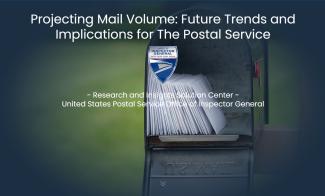Projecting Mail Volume: Future Trends and Implications for the Postal Service
- First-Class Mail and Marketing Mail include some of the Postal Service’s most well-known Market Dominant products and contribute about half of the Postal Service’s revenue.
- Mail volume peaked in 2006 and its decline over the past decade has been steep, mainly driven by the proliferation of digital alternatives. However, the United States remains the largest and one of the most affordable markets for mail.
- The USPS OIG projects that from 2025 to 2035 mail volume could decline a further 14 to 41 percent for First-Class and Marketing Mail depending on trends in economic conditions and electronic diversion. A baseline scenario where current trends continue could still see a 29 percent decline in volume.
- Americans will continue to depend on the Postal Service for essential communications and commerce. However, significant actions may be needed to allow USPS additional financial flexibility, cost-savings, or to generate additional revenue as traditional mail volumes decline.
Market Dominant mail classes, including First-Class Mail, Marketing Mail, and Periodicals, are some of the primary services the American public associates with the Postal Service. These classes contain well-known products like letters, postcards, advertising mail, bills, magazines, and newspapers.
While mail has been declining since 2006, mail still accounts for about half of the Postal Service’s revenue and the United States remains the world’s largest market for mail. The Postal Service plays a key role in ensuring the American public receives essential communications and products regardless of their location. However, the decline in mail volume in the last 10 years has been steep; First-Class Mail has declined 30 percent and Marketing Mail has declined 20 percent. This decline has been primarily caused by “electronic diversion,” the replacement of physical mail with electronic alternatives, including the internet, email, and text messages.
To project mail volume from 2025 to 2035, the U.S. Postal Service Office of Inspector General worked with WIK Consult to develop a simulation model. Scenarios in the model differ based on the rate of projected economic growth (low, steady, or high) and the rate of electronic diversion (steady or accelerated). The model projects mail volumes for the next decade in six separate scenarios, focusing on First-Class Mail and Marketing Mail. The intent of the model is to convey the potential trajectories of mail volume over the next decade, and not to predict precise volumes for any given year. While the model’s scenarios account for slow economic growth, it does not attempt to predict economic recessions, or other disruptions that could severely impact mail volume.
In a baseline scenario where current trends continue, combined First-Class and Marketing Mail volume is expected to decline 29 percent from 2025 to 2035, from 98.2 billion to 70.1 billion mailpieces. The best- and worst-case scenarios range from a relatively modest 14 percent decline to a much larger 41 percent decline. Even in the worst-case scenario, the U.S. will remain the largest mail market in the world. However, as the Postal Service looks to the future, preserving mail service and achieving financial sustainability in a world ever-more reliant on digital communication will be a growing challenge.

As mail volumes continue to decline in the future, significant actions may be needed to allow additional financial flexibility, save costs, or generate additional revenue. The Postal Service has stated it requires further legislative and regulatory action to be financially sustainable. The agency has requested congressional action, including increasing the agency’s debt limits, allowing expanded investment of retirement funds, reallocation of Civil Service Retirement System (CSRS) related expenses, and changing the administration of workers’ compensation.
As these and other proposals are considered, the Postal Service’s ability to ensure the affordability and reliability of mail service will be important to maintain its value proposition and prevent an acceleration in the decline of traditional mail volumes.
David Neu, Joy Sanzone, John Althen, and Hannah Xie contributed to this report.


